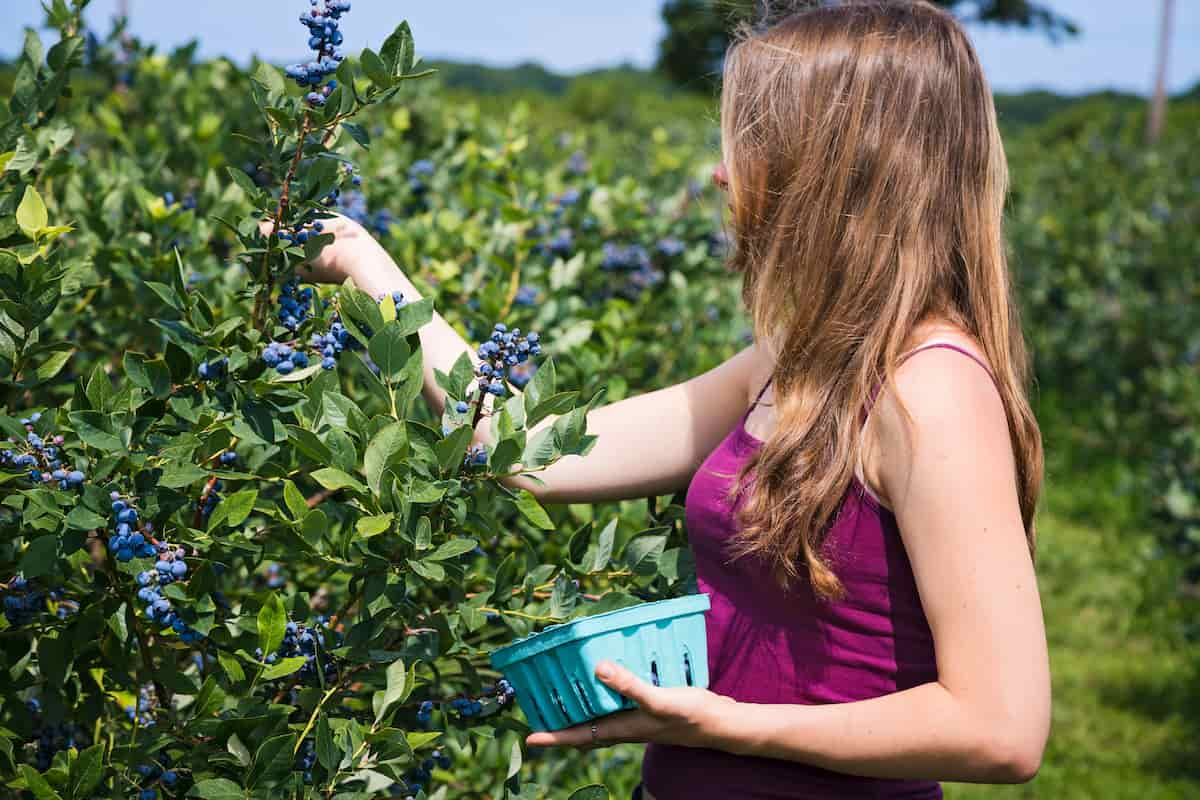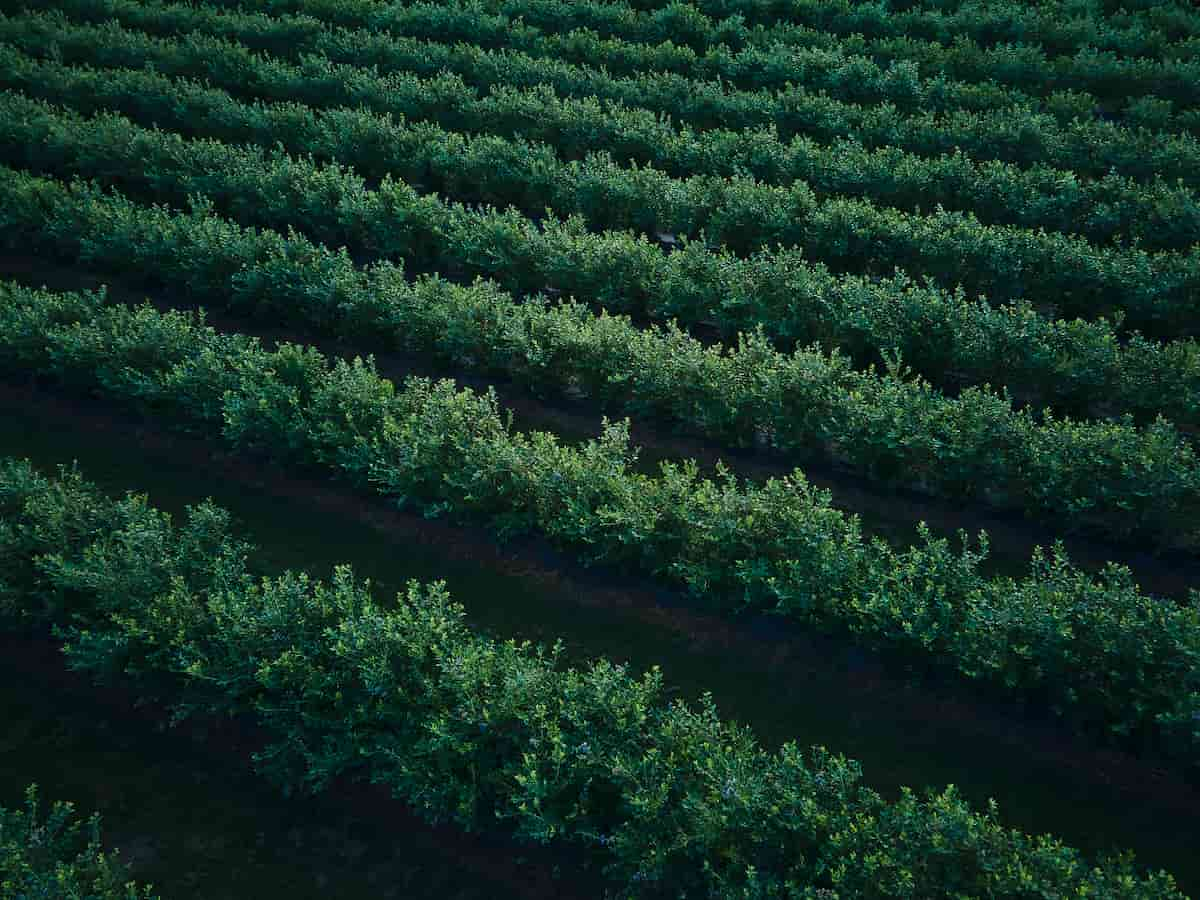Blueberry farming is a popular and lucrative business venture in the United States. Blueberries are tasty and rich in vitamins, antioxidants, and other nutrients. They are also a low-maintenance crop that is relatively easy to grow, making them an ideal choice for small and large-scale farmers alike. Below we learn the Blueberry cultivation guide, Blueberry Soil requirements, and a step-by-step guide to starting your own Blueberry farm.

How to Start Blueberry Farming in the USA
Location
The first step in starting a blueberry farm is to choose a suitable location. The ideal soil pH for blueberries is between 4.0 and 5.2. They also require full sun exposure for at least six hours a day. Choose a well-drained location with good air circulation to prevent disease. If your soil is not acidic, you may need to amend it with sulfur or another acidifier.
Soil Preparation
After choosing a suitable location, the next step is to prepare the soil. Blueberry bushes require soil with a high organic matter content. Prepare the soil by adding compost, aged manure, or other organic matter to increase the soil’s fertility. To enhance aeration and drainage in the soil, till it to a depth of between 8 and 10 inches. Preparing the soil at least a year before planting blueberries is important to allow the organic matter to break down and the soil pH to adjust.
Varieties
Several blueberry varieties are suitable for farming in the USA, including the Northern highbush, Southern highbush, and Rabbiteye. Choose a variety that is suitable for your location and soil type. Consult with local extension services or nurseries to determine which varieties are best suited for your area.
Planting
Plant blueberry bushes in the early spring or fall. Space the bushes 4 to 6 feet apart and plant them 1 inch deeper than they were grown in their nursery containers. Water the bushes thoroughly after planting. Be sure to plant at least two varieties of blueberries for cross-pollination, improving fruit production.
Fertilization
Blueberry bushes require regular fertilization to ensure healthy growth and fruit production. Apply a balanced fertilizer in the spring before the bushes start to grow. Apply another application of fertilizer after harvest to help the bushes prepare for winter. It is important not to over-fertilize blueberry bushes, leading to excessive vegetative growth and reduced fruit production.
Irrigation
Blueberry bushes require regular irrigation to ensure healthy growth and fruit production. Irrigate the bushes regularly during the growing season, especially during dry spells. Use drip irrigation or soaker hoses to prevent water from splashing on the leaves, which can lead to disease. It is important not to overwater blueberry bushes, which can lead to root rot.
Pruning
Pruning is an essential part of blueberry farming. Prune the bushes in late winter or early spring before the buds grow. Thin off overgrown branches and get rid of any dead or infected timber. Prune to maintain a balance between vegetative growth and fruit production. Overpruning can lead to reduced fruit production.
In case you missed it: How to Grow Blueberries Organically: A Step-By-Step Guide for Beginners

Pest and Diseases
Blueberry bushes , including mites, aphids, and powdery mildew, are susceptible to pests and diseases. To control pests, use organic pest control methods, such as insecticidal soap or neem oil. Use fungicides to control diseases such as powdery mildew. Monitor your bushes regularly and take action as soon as you notice any signs of pest or disease infestation. Maintaining a clean growing area and removing any fallen berries or debris that can harbor pests and diseases is important.
Harvesting
Depending on the variety, blueberries are typically ready for harvest in mid to late summer. The berries are ready to be picked when they become a deep blue colour. Use a gentle touch when picking the berries to avoid damaging the bushes. Be sure to harvest your blueberries regularly to avoid over-ripening and to maximize your yield. Blueberries can be hand-picked or machine-harvested, depending on the size of your operation.
Intercropping
Intercropping is a practice that involves planting different crops in the same field. Intercropping can help to increase soil fertility, reduce pest and disease pressure, and improve yields. Consider intercropping blueberries with other crops, such as strawberries or raspberries. Companion planting can also help to attract beneficial insects and repel pests.
Seasonal Management
Blueberry farming requires seasonal management, such as pruning, fertilizing, and pest control. Develop a seasonal management plan to ensure all tasks are timely. Keep accurate records of your farming activities, including fertilization, irrigation, and pest and disease control. This will help you identify trends and adjust for future growing seasons.
In case you missed it: How to Grow Strawberries in Greenhouse: A Step-By-Step Guide for Seed to Harvest

Conclusion
Starting a blueberry farm in the USA can be a profitable and rewarding business venture. With proper care and attention, your blueberry bushes will produce a bountiful harvest year after year.
- Ultimate Guide to Ossabaw Island Hog: Breeding, Raising, Diet, and Care
- Ultimate Guide to Juliana Pig: Raising Facts, Size, Diet, Care, and Lifespan
- Raising Lleyn Sheep: Disadvantages, Price, Uses, Characteristics, and Care
- Ultimate Guide to Meishan Pig: Breed Facts, Breeding, Raising, and Care
- Ultimate Guide to Teacup Pigs: Raising, Diet, Lifespan, Cost, and Care
- Guide to Raising Poll Dorset Sheep: Facts, Profile, Characteristics, Uses, and Care
- Ultimate Guide to Bighorn Sheep: Characteristics, Diet, Lifespan, Breeding, and Lifecycle
- Ultimate Guide to Raising Katahdin Sheep: Farming Facts, Breed Profile, Uses, and Care
- Ultimate Guide to Raising Oreo Cows: Belted Galloways Farming Facts, Profile, Uses, and Care